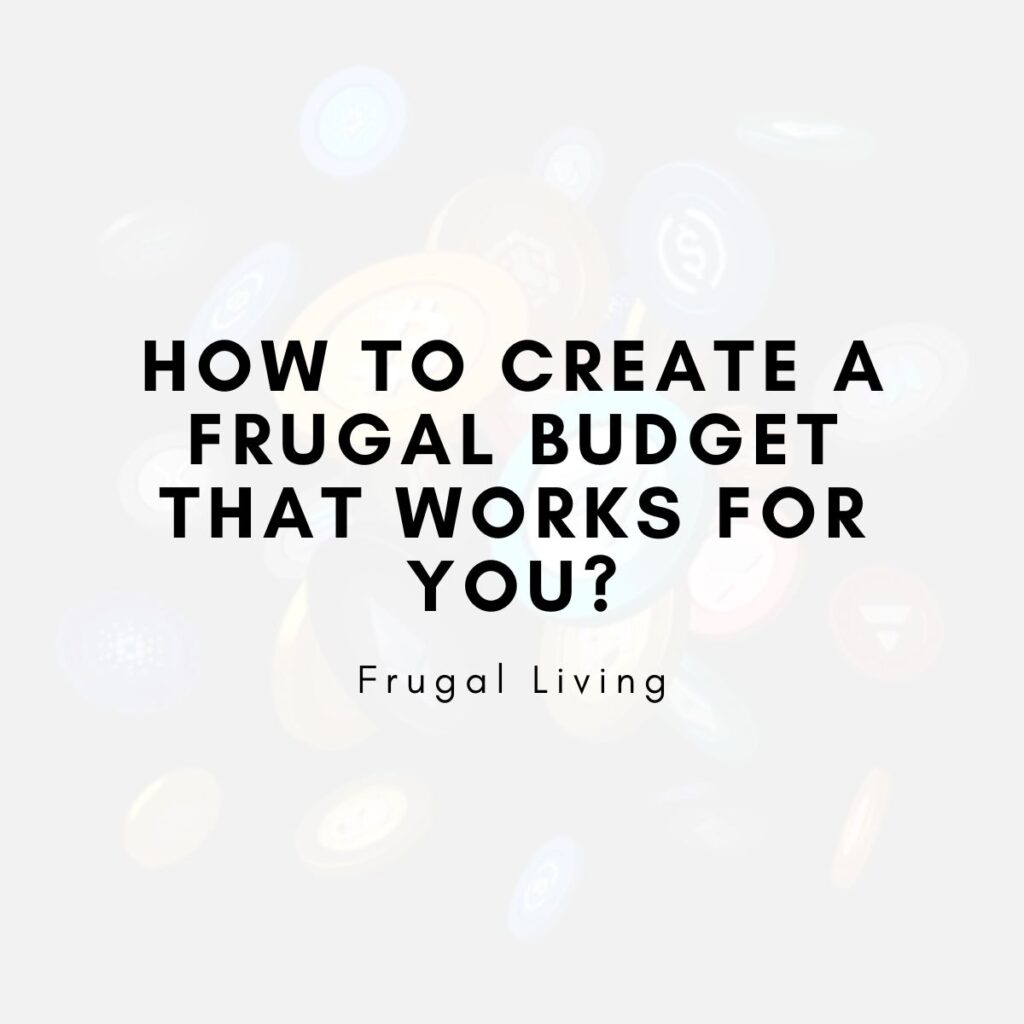
How to Create a Frugal Budget That Works for You?
Creating a frugal budget is a key step toward financial independence and effective money management. By prioritizing essential expenses, reducing unnecessary spending, and using smart strategies, you can build a budget that allows you to save more without sacrificing your lifestyle. In this guide, we’ll walk you through the steps to create a frugal budget that works for you.
Summary Table: How to Create a Frugal Budget That Works for You
| Section | Summary | Key Tips | Examples |
|---|---|---|---|
| Understanding the Basics of a Frugal Budget | A frugal budget helps allocate income to necessary expenses while saving for future goals. | Track your income and set realistic financial goals. | If your income is $3,000/month, set goals like saving $500 for emergencies and $200 for retirement. |
| List and Categorize Your Expenses | Identify your fixed (rent, utilities) and variable (groceries, entertainment) expenses. | Break down spending into fixed and variable categories for clarity. | Fixed expenses might include rent ($1,000/month) and utilities ($150/month), while groceries could be $300/month. |
| Identify Areas to Cut Back | Examine your spending to identify opportunities for reducing costs. | Review subscriptions, dining habits, and discretionary spending to find savings. | Cancel an unused streaming service ($12/month) or reduce dining out to save $100/month. |
| Set a Savings Goal | Set clear goals for saving an emergency fund, retirement, or other financial objectives. | Prioritize savings goals, such as 3-6 months of living expenses for emergencies or 10% of income for retirement. | Save $200/month for an emergency fund until it reaches $3,000 or allocate 10% of your income for retirement. |
| Implement the 50/30/20 Rule | Divide your income into needs (50%), wants (30%), and savings (20%) to maintain a balanced budget. | Stick to the rule to ensure you’re saving and living within your means. | For a $3,000 income, $1,500 goes to needs, $900 for wants, and $600 for savings. |
| Automate Your Savings | Automate your savings to ensure consistency and avoid spending temptation. | Set up automatic transfers for savings to retirement accounts or emergency funds. | Set up a direct deposit to automatically transfer $300/month into a retirement account. |
| Monitor and Adjust Your Budget Regularly | Regularly track and adjust your budget to stay on track and make improvements. | Use budgeting apps to track expenses, and adjust categories if you overspend. | Review monthly budget via apps like Mint and adjust by reducing entertainment spending if you overspent by $50. |
This table summarizes the main steps involved in creating a frugal budget, along with key tips and real-life examples to illustrate how to apply these strategies in your daily life. It’s designed to help you build a realistic and sustainable budget that works for your unique financial situation.
Introduction
Living frugally doesn’t mean living without; it’s about making intentional choices that allow you to save money for your future while maintaining a comfortable lifestyle today. One of the most powerful tools you can use to achieve this is a frugal budget. Whether you’re saving for a big goal, paying off debt, or simply trying to live more sustainably, creating a budget that prioritizes your financial goals is essential.
In this post, we’ll explore practical tips and strategies to create a frugal budget that aligns with your personal financial goals. We’ll look at how to track your income and expenses, set realistic goals, and find opportunities to cut costs—all while ensuring your budget remains sustainable and effective.
Understanding the Basics of a Frugal Budget
A frugal budget is a plan that allocates your income to necessary expenses while allowing for savings, debt repayment, and future goals. It involves mindful spending and prioritizing needs over wants. Let’s break down the key components of a frugal budget:
Income Tracking
Before you can create a budget, you need to understand your monthly income. This includes your salary, any freelance or side income, dividends, and interest. Knowing your total income will give you a clear idea of how much money you have to work with each month.
Setting Realistic Goals
Frugality is not about cutting back on everything; it’s about being intentional. Set clear, realistic goals such as saving for an emergency fund, paying off credit card debt, or contributing to a retirement account. These goals will guide your spending decisions and keep you motivated.
Step 1: List and Categorize Your Expenses
Start by tracking your monthly expenses. This is essential to understanding where your money is going. Categorize your expenses into fixed (e.g., rent, utilities) and variable (e.g., groceries, entertainment). Understanding these categories will help you identify areas where you can cut back.
Fixed Expenses
Fixed expenses are consistent month-to-month, and you can’t easily reduce them. These might include:
- Rent or mortgage payments
- Utility bills
- Car payments
Variable Expenses
Variable expenses are flexible and can often be adjusted:
- Groceries
- Dining out
- Entertainment
- Subscriptions
Step 2: Identify Areas to Cut Back
Now that you know where your money is going, look for areas to cut back. This is where frugality shines! Start small and focus on the most unnecessary spending.
Cancel Unused Subscriptions
Many people are unknowingly wasting money on subscriptions they don’t use. Review your subscriptions for things like streaming services, gym memberships, and magazine subscriptions. If you’re not using them regularly, consider canceling them.
Reduce Eating Out
Eating out can quickly eat into your budget. Try cooking at home more often and experimenting with meal prepping to save money on dining. Cutting back on restaurant meals could save you hundreds each month.
Step 3: Set a Savings Goal
Setting a savings goal is an essential part of budgeting. Whether you’re saving for an emergency fund, retirement, or a vacation, it’s important to have a goal in mind. Start by determining how much you’d like to save and set aside a portion of your income each month.
Emergency Fund
It’s essential to have an emergency fund to cover unexpected expenses, such as medical bills or car repairs. Aim to save at least 3-6 months’ worth of living expenses.
Retirement Savings
If you don’t already contribute to a retirement account like a 401(k) or IRA, now is the time to start. Even small contributions can add up over time, especially with compound interest.
Step 4: Implement the 50/30/20 Rule
One of the most common methods for budgeting is the 50/30/20 rule. This rule divides your income into three categories:
- 50% for Needs: Housing, utilities, groceries, insurance, and other essentials.
- 30% for Wants: Dining out, entertainment, hobbies, and non-essential purchases.
- 20% for Savings: This includes emergency funds, debt repayment, and retirement savings.
This rule can help you balance frugality with a reasonable lifestyle.
Step 5: Automate Your Savings
One of the best ways to stay consistent with your budget is to automate your savings. Set up automatic transfers from your checking account to your savings account or retirement fund. By automating your savings, you ensure that you’re putting money aside without the temptation to spend it.
Step 6: Monitor and Adjust Your Budget Regularly
A budget is not a one-time task; it’s an ongoing process. Track your progress regularly and make adjustments as needed. If you find that you’re consistently overspending in one category, make changes to ensure you stay on track with your goals.
Use Budgeting Tools
Apps like Mint, YNAB (You Need A Budget), and PocketGuard can help you track your spending and stick to your budget. These apps sync with your bank account, so you don’t have to manually input your transactions.
Conclusion
Creating a frugal budget is a powerful step toward achieving financial security and independence. By tracking your income and expenses, setting goals, and cutting back on unnecessary spending, you can create a budget that allows you to save for the future while living within your means. Remember, a successful budget is one that’s realistic, flexible, and aligned with your values and goals.
Key Takeaways:
- Track Your Income and Expenses: Understand where your money is going by tracking both fixed and variable expenses.
- Set Realistic Goals: Create achievable financial goals, such as building an emergency fund or saving for retirement.
- Cut Back on Unnecessary Spending: Identify areas where you can reduce costs, such as dining out and unused subscriptions.
- Use the 50/30/20 Rule: A balanced budget helps you allocate money for needs, wants, and savings.
- Automate Savings: Set up automatic transfers to ensure you save regularly.
- Monitor Your Progress: Regularly review your budget and adjust as necessary to stay on track with your goals.




